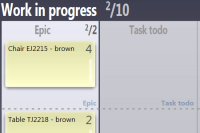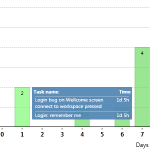 At the moment, more and more companies are turning away from the old project management practices and searching for the new trends like agile and one of its methodologies – scrum. While most are successful in adopting the new practices, some however are struggling. While the reasons vary from the incompatibility with the process to the feeling that the methodology is too strict, the end result is the same – a team that is not getting a 100% result. However there seems to be a solution on the horizon – scrumban.
At the moment, more and more companies are turning away from the old project management practices and searching for the new trends like agile and one of its methodologies – scrum. While most are successful in adopting the new practices, some however are struggling. While the reasons vary from the incompatibility with the process to the feeling that the methodology is too strict, the end result is the same – a team that is not getting a 100% result. However there seems to be a solution on the horizon – scrumban.
To put it simply scrumban is a mix of scrum and kanban. It takes certain components of both practices and mixes them together in order to create a new and enhanced one. In this post, however, we will not focus on the complete methodology, but instead we will take a look at how scrumban can improve the process of an unsuccessful scrum team. There are various reasons why teams find the scrum methodology unfitting – strictness, time constraints, continuous planning and others. For these teams scrumban is a great solution because it still has the main scrum principles and at the same time offers more flexibility and freedom to move forward.
With scrumban, the first changes come in the board and the way the process flow is visualized. The scrum board you previously had will stretch out in order to accommodate additional progress columns, representing each step of the user story from being created to being done. This will allow you to track the user stories moving across the board more precisely and to identify the ones that are having trouble right away.
The next big change in your process will be the planning and review meetings. Instead of having a standard meeting planned a long time in advance, they will only be organized when needed. Which means that you will be saving time otherwise dedicated to planning. Since there will be no planning meetings, there will no longer be sprints as well and the team will rely on the Kanban pull tactics, where they will take on new tasks from the project backlog based on their priority. In result, the team will have a clearer understanding of the scope of work yet to be done and will be more independent in taking up new tasks and completing them.
 As the sprints will no longer be organized, the way user stories in progress are limited will change as well. Kanban WIP (work in progress) limits are introduced in scrumban, limiting the amount of user stories that can be worked on at one time. This ensures that with the amount of user stories not limited for a certain period of time, team members are still controlled and will have to first finish the user stories they are currently working on, before taking up new ones. In other words, it will ensure that the process is moving along step by step with the team being able to start only a certain amount of tasks at a time.
As the sprints will no longer be organized, the way user stories in progress are limited will change as well. Kanban WIP (work in progress) limits are introduced in scrumban, limiting the amount of user stories that can be worked on at one time. This ensures that with the amount of user stories not limited for a certain period of time, team members are still controlled and will have to first finish the user stories they are currently working on, before taking up new ones. In other words, it will ensure that the process is moving along step by step with the team being able to start only a certain amount of tasks at a time.
The one thing that will stay more or less the same when switching to scrumban is the daily meetings. However, they will be focused on separate user stories moving along the progress comlumns and any problems that they are encountering. The main goal of the daily meetings will be to update the team on the progress, to identify the user stories that are having trouble and to find a solution or to allocate additional resources so the progress of the whole project is going forward.
Lastly, the user stories can still be estimated in the story points, however scrumban does introduce a new and valuable metric – cycle time. It defines how much time a story take to be completed and provides a better estimation of the project duration and resources necessary. It can also help identify problematic user stories, by keeping track of the average cycle time and looking for any deviations that would indicate team members facing difficulties.
Scrumban is an extension of both scrum and Kanban, striving to create the best project management experience for the whole team. For the problematic scrum teams, it brings a more relaxed project management attitude and additional tools and metrics to make sure that the end goal is reached in time. Scrumban can prove to be a great option for the scrum teams struggling to finish the user stories in time, sacrificing quality and feeling under pressure. However it should be implemented step by step and only when it is actually the best solution, otherwise it may prove to be just as harmful as the methodology used previously.






